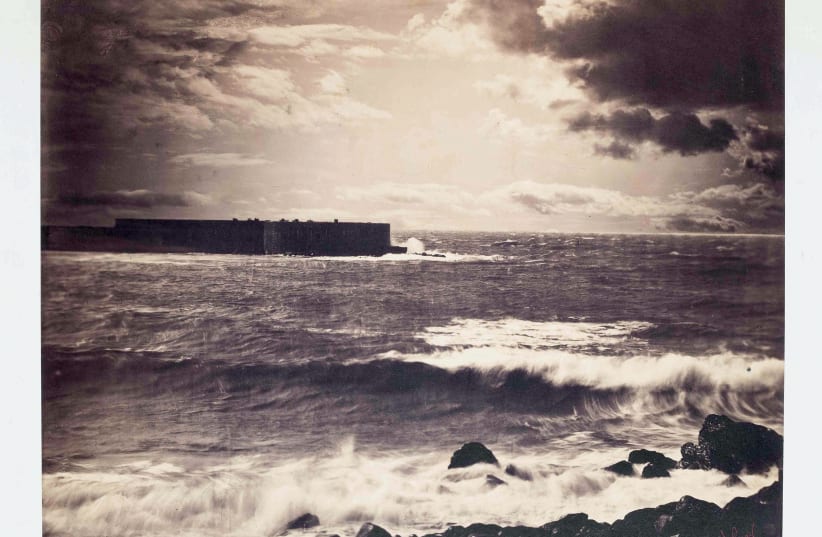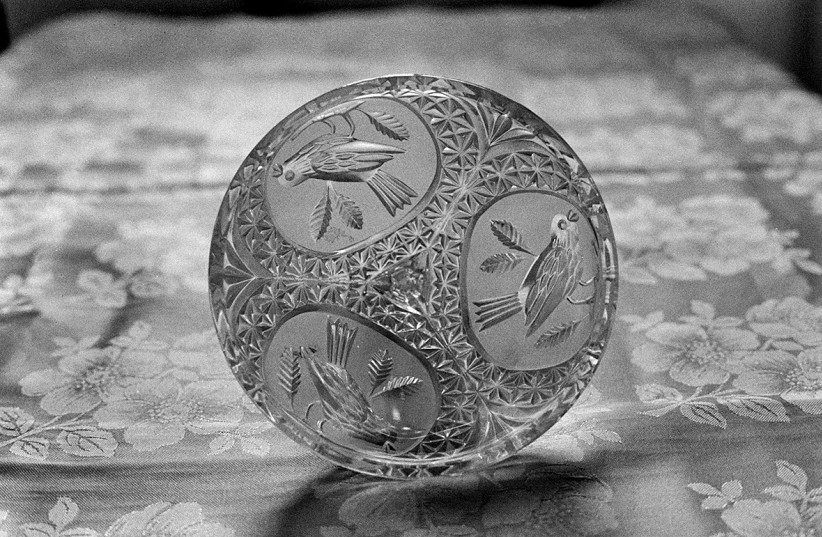
We should all know by now that we don’t live in a black-and-white world, in all sorts of senses. That has applied to the field of photography for over a century and a half, although the vast majority of prints shot by the street-level consumer were monochrome until around the 1960s.
Chromic divide aside, light is surely the most important core element of photographic creation. The earliest cameras, in the first half of the 19th century, were just pinhole affairs – aka camera obscura – which admitted light into a dark area and projected an image on the rear surface. Gradually, smaller, more user-friendly cameras took over the market as lenses, dry plates, and roll film allowed the less-than-well-heeled to also snap away.
Some of that vibe and zeitgeist is currently on show at Ticho House, the downtown offshoot of the Israel Museum, where the “Recollection” exhibition is now on display.
Interestingly, the Hebrew title, “Asufat Or,” which translates as “collection of light,” references that basic factor in the photographic process, while the English name “Recollection” doesn’t.
Be that as it may, the temporal throwback aspect is evident from the off. Considering that the “Recollection” spread was culled from the Israel Museum’s gargantuan trove of photographs, which runs to over 100,000 works, that was probably a given.
“It is the largest collection in the Israel Museum, and the most significant collection of photographs in the whole of the Middle East,” Tamara Abramovitch proudly notes. “It spans the entire history of photography. We have photographs dating back to 1840, up to the present day.” Not bad going.
But this is no mere historical trip down image memory line. This is very much a broad time spectrum-spanning endeavor, and an attempt to bring some of those yesteryear gems right up to speed.
“In 2022, we invited six artist-photographers to come to the museum and explore the collection,” Abramovitch, who co-curated the exhibition with Ilanit Konopny, explains.
That presented something of a philosophical conundrum. Surely, photography of the stills variety is about freezing a moment in time for all perpetuity. And here we are dragging frames captured long before even motor cars were a twinkle in inventors’ eyes, let alone digital cameras, into the here and now.
Abramovitch doesn’t have a problem with that. “We have such an amazing collection at the museum. Why should we just let it lie around hidden? We thought, ‘Let’s give it an airing, let’s revitalize it.’”
Trolling such a mass of prints and plates would probably have taken the commissioned artists until well after the cows, and any other farm animals, had wended their way back home. Hence, the curators ran their practiced eyes over the treasure trove in advance of the final selection stage.
“We chose some photographs for the artists to consider working off, and then we showed them the full catalogue,” Abramovitch continues.
Of course, even the curators couldn’t plow their way through in excess of 100,000 artifacts, either. The artists helped point the way.
“They all knew they wanted to relate to early photography from the 19th century,” says Abramovitch. “They wanted to address the tension between the different eras. They said they wanted to go way back, and we took out works based on that.”
Looking back, looking forward
The sense of bookend stretch is certainly there in “Recollection.” The earliest print on show dates back to circa 1850, taken by a Frenchman with an instantly recognizable surname. The Hermitage of the Castle was crafted by a certain Charles-Victor Hugo, son of Victor Hugo, France’s revered Romantic poet, novelist, and dramatist.
This was not a matter of protekzia that got Hugo Jr. a berth in the exhibition. “He was an excellent photographer,” states Abramovitch.
He was, it seems, quite a groundbreaker. “We are used to looking at horizontal landscapes,” she says. “Here is a vertical frame.”
It isn’t just the dimensions that make the Hugo shot worth its place in the annals of the discipline. “This is a very important juncture in the evolution of photography. Rural areas were not generally photographed in those times. They were considered poetic and for painting, not photography.”
It is a mysteriously fetching picture with an intriguing composition. It is also a little surrealistic, and you need to spend a few moments with it in order to figure out the pictorial and physical lay of the land.
Old and contemporary works are, naturally, exhibited in communicative or oxymoronic tandem. Hugo’s present-day match-up was created by 48-year-old Rami Maymon, who came up with something described as a “photomontage, archival pigment print” which mirrors the fragmentary makeup of the mid-19th-century work. “Rami really jumped on the Hugo picture. He was taken with the unclear nature of it. Is it abstract? Is it a building? It is very deceptive.”
Indeed it is. Maymon took a clinical approach to his subject. “He divided up his [pair of] pictures into three sections – the land, sea, and sky – and created new compositions. They offer a new perspective and also relate to texture.” The latter, in particular, comes through in the intentionally blurry grainy prints.
We move on to an evocative dramatic scene shot by another Frenchman, Gustave Le Gray, a seascape taken in 1857 called The Great Wave.
Le Gray clearly had a good handle on how to balance light and shadow, and on visual layering. It is a compelling print made from a glass negative treated with collodion, which was the de rigueur coating used with wet-plate photography before gelatin emulsions superseded it.
The celestial source of light, framed by dark clouds on the horizon, and deftly echoed by the foam of the waves as they roll into terra firma and eddy between rocks, puts one in mind of Turner’s gripping scenic renditions. That line of thought makes more sense when we learn that Le Gray started out as a painter before turning his gifts to photography and becoming a seminal figure in the evolving art form.
The Frenchman also had a firm grasp of the technical nuances of capturing both sea and sky, with their vastly contrasting light levels, and was clearly an inventive chap adept at problem-solving. Achieving a balancing act between such disparate light intensities is challenging enough today, with all the technological paraphernalia. Back then, photographic materials were highly unstable and very sensitive to light.
Le Gray craftily dodged that bullet by producing two negatives at different exposure levels and printing them together. The result is a stunning seascape of striking depth and intensity.
THE CURATORS chose to place all the old works set back in wall niches, which immediately and palpably distinguishes them from the offerings of the present-day sextet which, besides Maymon, includes Hadas Satt, Etty Schwartz, Tamar Latzman, Irit Tamari, and Thalia Hoffman.
The Great Wave is partnered by another print of yore, a lyrical effort by late-19th, early 20th-century American photographer Anne Brigman. Tellingly, her creative talents also found an outlet in poetry. Brigman also followed the tenets of pictorialism, which fed off a photographic idiom anchored in principles relating to photography’s role as a bona fide art form.
Her work, Invictus, features a nude woman posing adroitly from within the hollowed-out trunk of an ancient tree. Brigman employed a soft focus approach – as was her wont – which serves to create an aesthetic continuum between the arboreal and human physicalities.
The history of art is littered with polemics between the Establishment folk and the new upstarts on the artistic block. It may be hard to believe now but the Impressionists, for example, were initially stonewalled by the Le Salon official exhibition honchos. That is human nature, as newcomers with different ideas arrive on the scene and upset the applecart, which, naturally, also met with strong opposition from the powers that be back in the day.
“You could say that, right from the start [of photography], [renowned French poet Charles] Baudelaire writes, around 1850, a manifest against photography being seen as art,” Abramovitch notes. “That means that there were those who did consider it art.”
She says it took a while before opinion swung to stay. “I think that by the beginning of the 20th century, it is clear to everyone that it is art.”
That was largely thanks to the efforts of Jewish American photographer Alfred Stieglitz, who pushed for acceptance, inter alia, via the Camera Work journal of art – by definition, including photography – he published in New York between 1903 and 1917.
Hadas Satt takes a leaf out of Le Gray’s book, using, of course, far more advanced technological means, to marry segments of negative images she took on good old 35-mm. film. That also echoes Brigman’s fusion of feminine figures with Mother Nature’s offerings.
In so doing, and with more than a nod in the direction of those 19th-century envelope pushers, Satt, too, thumbs her nose at the prosaic practice of just snapping what’s in front of your camera lens or, far more likely these days, cellphone.
Surreal and womanly touches
We, once more, venture into the realms of surrealism with Drops of Rain, shot in 1908 by Clarence Hudson White.
This is one for the rank and file, as White began his working life as a bookkeeper at a grocery store. He became besotted with photography at the Chicago World’s Fair in 1893 and subsequently devoted practically every waking moment outside his daytime job to furthering his newfound craft, scrimping and saving to purchase the requisite expensive equipment and raw materials.
Drops of Rain shows White’s young son looking wondrously at a large glass ball as raindrops cling to a window pane. It is a captivating scene attained through the skillful use of sharp and soft focus which imbues the domestic setting with a magical ambiance.
Schwartz resonates that balance of the corporeal and the rivetingly ethereal with the quizzically named From Itself to It, which also conveys the sense of mystical dome scratcher with regard to equating clearly contrasting, yet somehow complementary, square and circle shapes.
By now, it had become refreshingly clear that there were quite a few women among the early snappers. That also led to works that referenced traditional female roles, such as American photographer Gertrude Käsebier’s playfully pastoral scene of a woman feeding ducks.
The contemporary sounding board for that comes in the form of Latzman’s Gentle Sorrow (Woman Feeding a Duck). It is, says Abramovitch, par for Latzman’s run of the familial mill. “She is a mother, and she takes pictures during everyday family activities and events.” Latzman has a slew of frames that feed off intriguing excerpts of quotidian life.
“Recollection” provides some insight into the improbable dialogue between the way things once were, in more innocent times, and how the current gifted crop view those pioneering efforts a century or more on through the prism of 21st-century technology, nous, and cultural and emotional baggage.■
‘Recollection’ closes in October. For more details: www.imj.org.il/en/wings/arts/ticho-house













